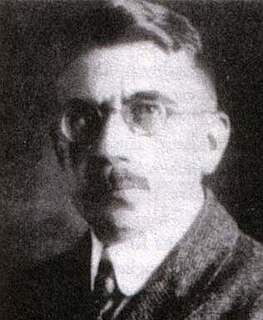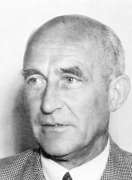
Cryptanalysis is the study of analyzing information systems in order to study the hidden aspects of the systems. Cryptanalysis is used to breach cryptographic security systems and gain access to the contents of encrypted messages, even if the cryptographic key is unknown.

The Enigma machine is a cipher device developed and used in the early- to mid-20th century to protect commercial, diplomatic, and military communication. It was employed extensively by Nazi Germany during World War II, in all branches of the German military. The Germans believed, erroneously, that use of the Enigma machine enabled them to communicate securely and thus enjoy a huge advantage in World War II. The Enigma machine was considered to be so secure that even the most top-secret messages were enciphered on its electrical circuits.

In the history of cryptography, the ECM Mark II was a cipher machine used by the United States for message encryption from World War II until the 1950s. The machine was also known as the SIGABA or Converter M-134 by the Army, or CSP-888/889 by the Navy, and a modified Navy version was termed the CSP-2900.

William Frederick Friedman was a US Army cryptographer who ran the research division of the Army's Signal Intelligence Service (SIS) in the 1930s, and parts of its follow-on services into the 1950s. In 1940, subordinates of his led by Frank Rowlett broke Japan's PURPLE cipher, thus disclosing Japanese diplomatic secrets before America's entrance into World War II.
In cryptography, the ADFGVX cipher was a manually applied field cipher used by the Imperial German Army during World War I. It was used to transmit messages secretly using wireless telegraphy. ADFGVX was in fact an extension of an earlier cipher called ADFGX which was first used on 1 March 1918 on the German Western Front. ADFGVX was applied from 1 June 1918 on both the Western Front and Eastern Front.

Arthur Scherbius was a German electrical engineer who invented the mechanical cipher Enigma machine. He patented the invention and later sold the machine under the brand name Enigma.
In cryptography, Russian copulation is a method of rearranging plaintext before encryption so as to conceal stereotyped headers, salutations, introductions, endings, signatures, etc.. This obscures clues for a cryptanalyst, and can be used to increase cryptanalytic difficulty in naive cryptographic schemes. This is of course desirable for those sending messages and wishing them to remain confidential. Padding is another technique for obscuring such clues.
In cryptography, a password-authenticated key agreement method is an interactive method for two or more parties to establish cryptographic keys based on one or more party's knowledge of a password.

Friedrich Ludwig "Fritz" Bauer was a German pioneer of computer science and professor at the Technical University of Munich.

Fritz Erich Fellgiebel was a German Army general and a conspirator in the 20 July plot to assassinate Nazi dictator Adolf Hitler. In 1929, Fellgiebel became head of the cipher bureau of the Ministry of the Reichswehr, which would later become the OKW/Chi. He was a signals specialist and was instrumental in introducing a common enciphering machine, the Enigma machine. However, he was unsuccessful in promoting a single cipher agency to coordinate all operations, as was demanded by OKW/Chi and was still blocked by Joachim von Ribbentrop, Heinrich Himmler and Hermann Göring until autumn 1943. It was not achieved until General Albert Praun took over the post.

The OMI cryptograph was a rotor cipher machine produced and sold by Italian firm Ottico Meccanica Italiana (OMI) in Rome.

In the history of cryptography, 91-shiki ōbun injiki or Angōki Taipu-A, codenamed Red by the United States, was a diplomatic cryptographic machine used by the Japanese Foreign Office before and during World War II. A relatively simple device, it was quickly broken by western cryptographers. The Red cipher was succeeded by the Type B "Purple" machine which used some of the same principles. Parallel usage of the two systems assisted in the breaking of the Purple system.
The Short Weather Cipher, also known as the weather short signal book, was a cipher, presented as a codebook, that was used by the radio telegraphists aboard U-boats of the German Navy (Kriegsmarine) during World War II. It was used to condense weather reports into a short 7-letter message, which was enciphered by using the naval Enigma and transmitted by radiomen to intercept stations on shore, where it was deciphered by Enigma and the 7-letter weather report was reconstructed.

Wilhelm Tranow was a very successful German cryptanalyst, who before and during World War II worked in the monitoring service of the German Navy and was responsible for breaking a number of encrypted radio communication systems, particularly the Naval Cypher, which was used by the British Admiralty for encrypting operational signals and the Naval Code for encrypting administrative signals. Tranow was considered one of the most important cryptanalysts of B-service. He was described as being experienced and energetic. Little was known about his personal life, when and where he was born, or where he died.
Erich Hüttenhain was a German academic mathematician and cryptographer (Cryptography) and considered a leading cryptanalyst in the Third Reich. He was Head of the cryptanalysis unit at OKW/Chi, the Cipher Department of the High Command of the Wehrmacht.

The Discriminant Book shortened to K-Book (K. Buch), and also known as the indicator group book or identification group book was a secret distribution list in booklet form, which listed trigraphs in random order. The Kenngruppenbuch was introduced in May 1937, and used by the Kriegsmarine during World War II as part of the Naval Enigma message encipherment procedure, to ensure secret and confidential communication between Karl Dönitz, Commander of Submarines (BdU) in the Atlantic and in the Mediterranean operating German submarines. The Kenngruppenbuch was used in the generation of the Enigma message Key that was transmitted within the message Indicator. The Kenngruppenbuch was used from 5 October 1941, for the Enigma Model M3, and from 1 February 1942 exclusively for the Enigma M4. It must not be confused with the Kenngruppenheft which was used with the Short Signal Book.
Wolfgang Franz was a German mathematician who specialized in topology particularly in 3-manifolds, which he generalized to higher dimensions. He is known for the Reidemeister–Franz torsion. He also made important contributions to the theory of lens spaces.
Kurt Selchow was a Minister and Director of the Z Branch, the Signal Intelligence Agency of the German Foreign Office before and during World War II.

Otto Leiberich was a German cryptologist and mathematician. Leiberich is most notable for establishing the Bundesamt für Sicherheit in der Informationstechnik in 1991.
Hans Karl Georg Heinrich Pietsch was a German mathematician who was most notable for being a director of the Mathematical Referat of the Wehrmacht signals intelligence agency, the General der Nachrichtenaufklärung during World War II.













